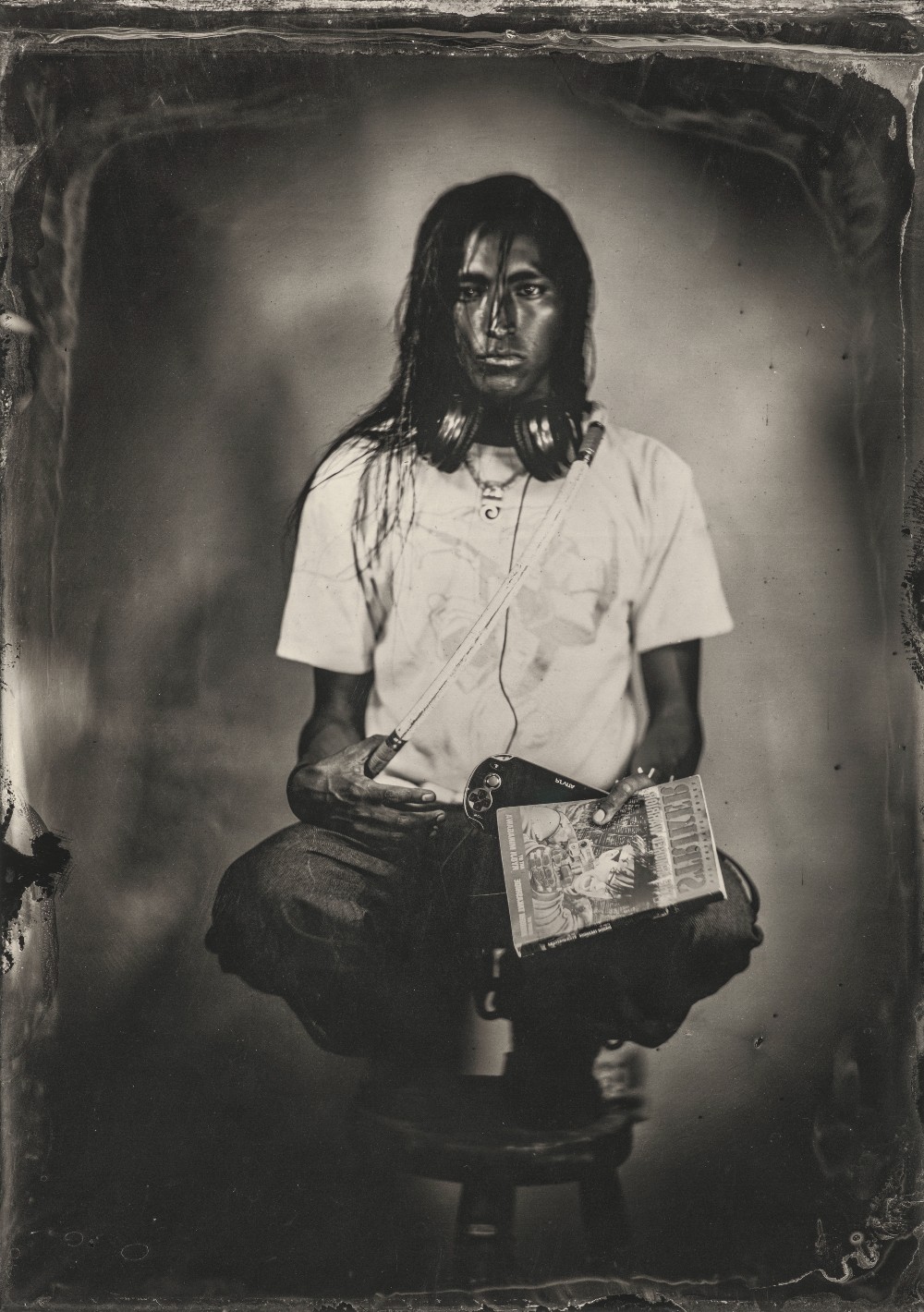
- Details
- By Chadd Scott
There is a perception of Native people still widely held in the United States: Google Image search “Native American” and at the top of the search will likely be archaic photos of Native Americans taken by Edward Curtis–tin types and sepia toned. These outdated images continue to inform a style that over a century later dominates museum exhibitions and the tops of Google searches: the Indian in a headdress, bareback on a horse, etc. Diné photographer Will Wilson uses the very tin type and sepia that froze Native Americans in the past to shatter the myth and bring Natives very much into contemporary, modern art.
Wilson’s latest exhibition, In Conversation: Will Wilson, investigates the legacy of historical photographs on the representation of Native peoples in North America. It opened on July 9 at the Delaware Art Museum.
“People don’t want to deal with the traumatic reality of history, of genocide, of attempted ethnic cleansing,” Wilson told Native News Online. “They’d rather see these noble, beautiful images of a ‘better time.’ I want to make the case that we’re still here doing interesting and important things.”
Wilson’s work strikingly portrays contemporary Indigenous people, using a similar photo process to those used historically. The resulting contradiction – contemporary Native people photographed historically – demands onlookers examine how they imagine Native people, what myths they hold on to, and why those myths exist.
Alongside portraits previously taken by Wilson, In Conversation debuts new images he created from a May visit with citizens of the Lenape Indian Tribe of Delaware and the Nanticoke Indian Association.
“I didn’t know much about that cultural history, but it’s always amazing to go as a photographer with an open mind and engage a community and see how people want to represent themselves,” Wilson said. “Something that’s happened recently, and it’s part of this whole reckoning around race and acknowledgment and land acknowledgments with museums in particular – thinking about who the original stewards of space are – people have seen this project as an opportunity to do a little bit more than just put a statement on a gallery entrance. To use [my photography] as a vehicle to reach out to a community, establish a relationship, and also acknowledge through photography the relationship of the Indigenous people who are still very much around and have a stake in how land is managed and how representation happens.”
Wilson’s images of the Lenape and Nanticoke will be used by the Delaware Art Museum moving forward to increase representation of Indigenous people within its walls. The museum hosted a powwow and storytelling event to coincide with the exhibition opening to further demonstrate its increased commitment to acknowledging and promoting Indigenous culture.
In Conversation: Will Wilson is on view through September 8, 2022. Wilson has another solo exhibition through December 11, 2022, at the Southeast Center for Contemporary Art in Greensboro, North Carolina. His work is also displayed in an upcoming group show at the Utah Museum of Fine Arts in Salt Lake City, and in the recently reopened permanent exhibition at the Museum of Indian Arts and Culture in Santa Fe.
Help us tell the stories that could save Native languages and food traditions
At a critical moment for Indian Country, Native News Online is embarking on our most ambitious reporting project yet: "Cultivating Culture," a three-year investigation into two forces shaping Native community survival—food sovereignty and language revitalization.
The devastating impact of COVID-19 accelerated the loss of Native elders and with them, irreplaceable cultural knowledge. Yet across tribal communities, innovative leaders are fighting back, reclaiming traditional food systems and breathing new life into Native languages. These aren't just cultural preservation efforts—they're powerful pathways to community health, healing, and resilience.
Our dedicated reporting team will spend three years documenting these stories through on-the-ground reporting in 18 tribal communities, producing over 200 in-depth stories, 18 podcast episodes, and multimedia content that amplifies Indigenous voices. We'll show policymakers, funders, and allies how cultural restoration directly impacts physical and mental wellness while celebrating successful models of sovereignty and self-determination.
This isn't corporate media parachuting into Indian Country for a quick story. This is sustained, relationship-based journalism by Native reporters who understand these communities. It's "Warrior Journalism"—fearless reporting that serves the 5.5 million readers who depend on us for news that mainstream media often ignores.
We need your help right now. While we've secured partial funding, we're still $450,000 short of our three-year budget. Our immediate goal is $25,000 this month to keep this critical work moving forward—funding reporter salaries, travel to remote communities, photography, and the deep reporting these stories deserve.
Every dollar directly supports Indigenous journalists telling Indigenous stories. Whether it's $5 or $50, your contribution ensures these vital narratives of resilience, innovation, and hope don't disappear into silence.
 The stakes couldn't be higher. Native languages are being lost at an alarming rate. Food insecurity plagues many tribal communities. But solutions are emerging, and these stories need to be told.
The stakes couldn't be higher. Native languages are being lost at an alarming rate. Food insecurity plagues many tribal communities. But solutions are emerging, and these stories need to be told.
Support independent Native journalism. Fund the stories that matter.
Levi Rickert (Potawatomi), Editor & Publisher
